
The Ultimate Horizon Review
The Ultimate Horizon Review
The Award-Winning Horizon: The power of good design.
By: Don Cohen
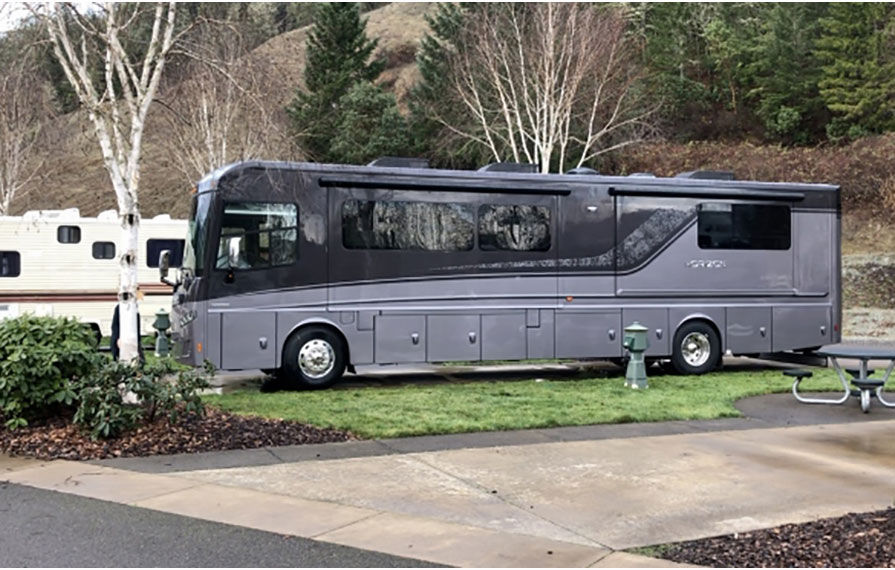
My wife Terry and I felt like lottery winners when we were asked to take a brand-new Winnebago Horizon for a two and a half month livability test. In the last five years, we had criss-crossed North America putting 80,000 miles on two Navions. We were drawn to the Navion for its simplicity, ease of driving, and clean Euro-inspired interior.
Most of our friends owned big rigs and a group of our former Vail Valley neighbors kept insistently inviting us to join them in their winter escape in Indio, California. Indio is in the Coachella Valley and is one of several linked desert cities in a 30-mile long swath with Palm Springs on the north and Indio on the south. The RV parks and resorts in the area start to fill in November and pretty much empty out in April.
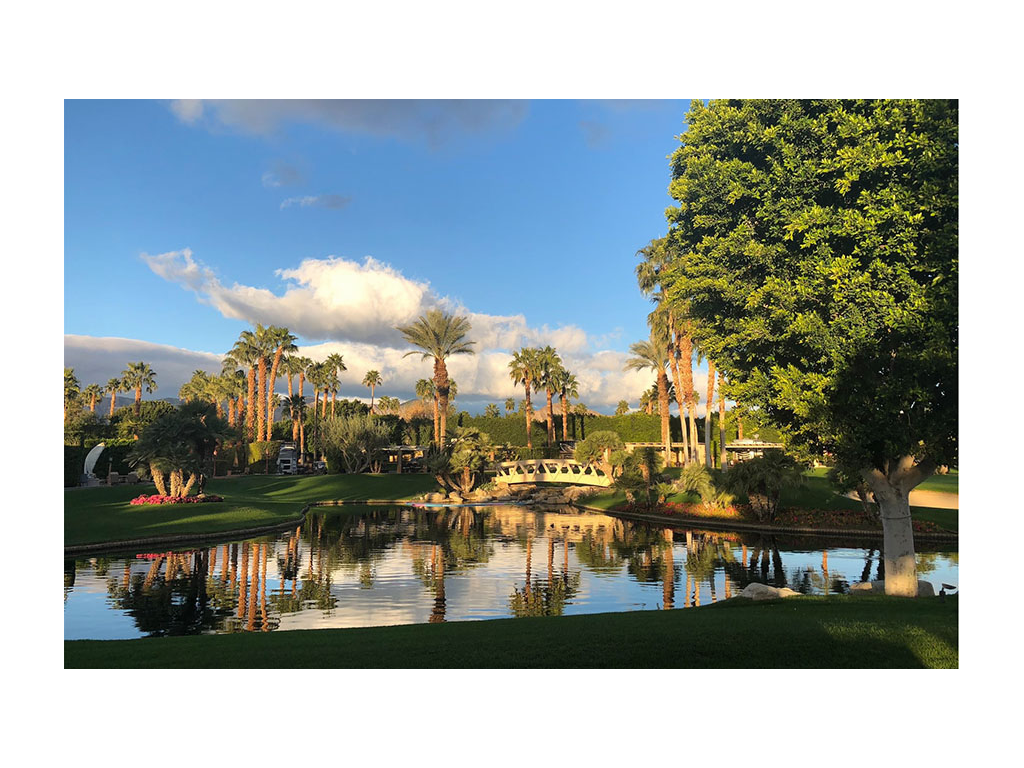
The view from the patio at Outdoor Resorts where the Horizon was parked looking west toward the San Jacinto mountains.
All our friends are at the Outdoor Resorts Indio, where the driveway lots are all owner owned and some are available in the resort’s rental pool. While the word resort is all too frequently paired with the word RV, it is most often mischaracterized at best and misleading at worst. However, in the case of ORI, the word resort is 100% true with many lots on the private golf course along with a clubhouse and restaurant, tennis, pickleball, lap pool, exercise room, and activities director all on-site.
Most lots have outdoor kitchens and the trend is to build much more substantial covered structures with TVs, fire tables, full gourmet kitchens, electric heaters, and even washers and dryers.
However, ORI only permits Class A vehicles (at least 28-feet long and newer than 10 years), so as lovely as our Navion is, it wouldn’t qualify. Needless to say, leaving a Colorado winter behind, living in a first-class resort and getting to do it in an ultra-modern motorhome truly was a lottery win.
Getting started
In late January, we flew up to Winnebago’s Junction City, Oregon, plant that is just north of Eugene. We spent a day picking up some basic road essentials between Costco, Target, Macy’s and Camping World - just enough to start living in the unit on day one as we would then spend the next few days driving the thousand miles to Indio. I had pretty limited diesel pusher driving experience, and you can read more about how I came up the learning curve by reading this story.
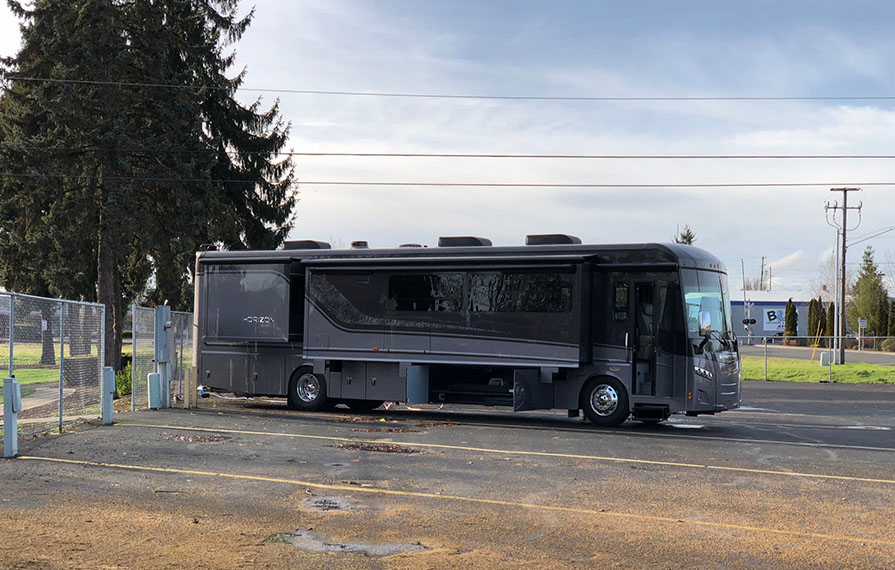 Night number one. We use Winnebago's complimentary hook-ups a block from the customer service facility in Junction City, Oregon.
Night number one. We use Winnebago's complimentary hook-ups a block from the customer service facility in Junction City, Oregon.
Because Terry and I are well-seasoned RVers, once we got on the highway and then exited later for an evening at a campground, the evening set-up and morning road-ready processes with the Horizon was pretty simple. Our four days on the road gave us plenty of time to test the mobile systems. And, once we set the jacks on the drive in Indio, we now had plenty of day-to-day time to settle in and learn all the house systems in depth.
Design matters
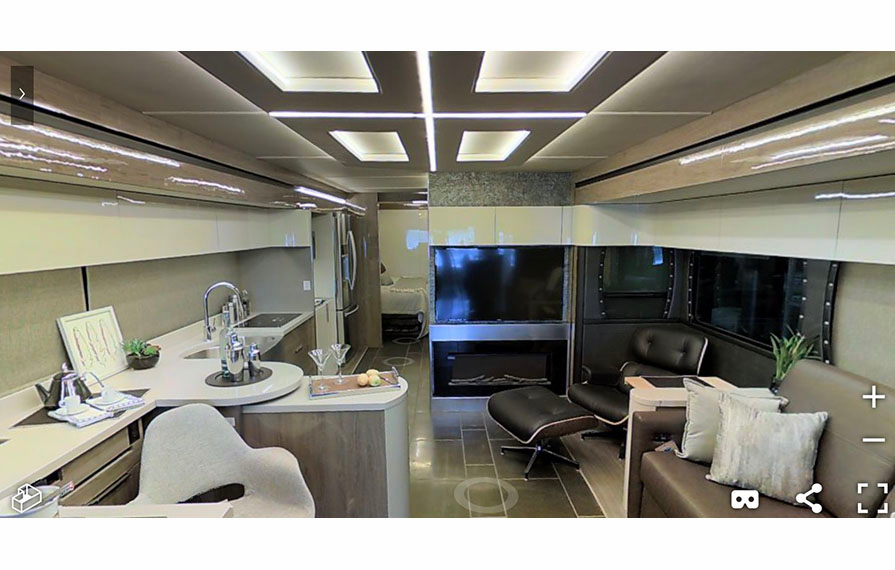
Amazingly close to the original vision. A rare photo of the hand-built mock up of the Horizon two years before it was announced.
The reason the Horizon won the RV Business 2018 “RV of the Year” award is simple: design. Both inside and out. It was a long three-year journey from concept to showroom (you can read a companion story here). It starts with the refreshing disappearance of exterior swirls and complex patterns that vaguely channel abstract coats of arms. I guess the best way to describe the exterior effect is more color and less drama. Our test Horizon is very understated with a dark gray base and black accent color. My personal preference is the clean white with the high contrast of the black side element. But no matter your choice of exterior paint scheme, the effect is obvious: this is a different RV with a design that will appear less dated as the years go by.
As I’ve come to describe the Horizon to RV friends, I’ve got my sound bites down cold: there are no puck lights (except hidden in the closet), no external cabinet hardware and no RV wallpaper. You can’t make that claim in my friends’ high-end Newmars or Newells.
(Click here to watch an in-depth video walk-through of the Horizon 40A)
21st century interior features
When RV-savvy visitors walk into the Horizon, there are two universal comments. The first is how open it feels. That’s due to the expansive windows that aren’t separated by mullions or screens. The second is the ceiling. A slim center canopy drops slightly from the ceiling with embedded LED lighting. Gone are the mirrors, scrolls, pedestrian hardware, and impractical elements that confuse ornateness with class.
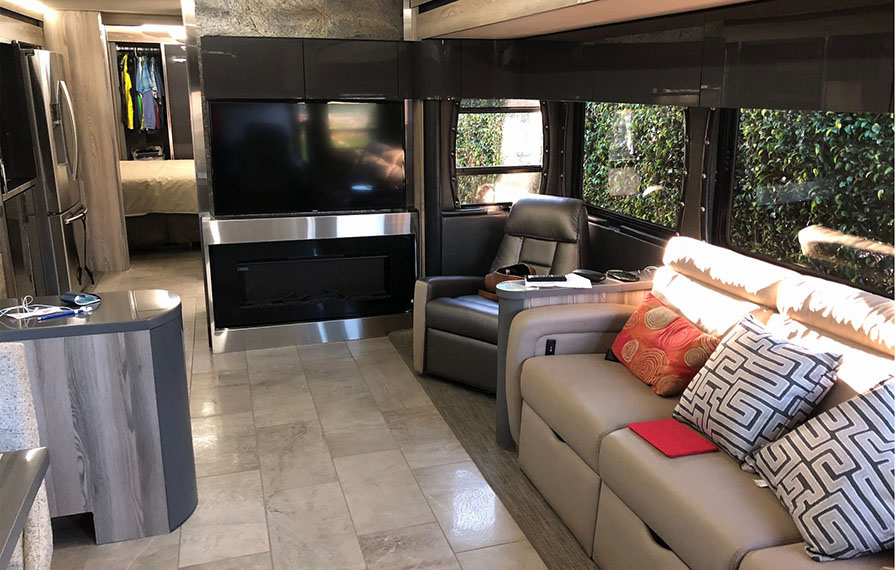 Our orange pillows from our loft in Denver added a personal touch to our winter home.
Our orange pillows from our loft in Denver added a personal touch to our winter home.
The color palette of this particular Horizon is the Briarwood/Hemetite combination. I was worried that the dark gray counters would be too dark, but it isn’t at all. The lighter Ultraleather fabric, light-color porcelain and medium toned wood and laminate coverings are surprisingly light feeling. On the galley side, the liberal use of stainless steel for the back and side splashes really amp up the modern feeling without overtly calling your attention to them.
The bath design, with two entry points, stops people in their tracks. It’s here that the size, functionality, lighting and storage completely reset one’s expectations of an RV bath. Yes, there are more expansive baths (including the larger 43’ Horizon floorplan), but you won’t find any more comfortable to spend time in. It makes me smile every morning.
Most of the high-gloss cabinets have hidden hardware and when a pull is installed, it’s slim chrome almost disappears, yet is comfortable to pull on. As I write this review, I’m sitting in the living room lounge and as I look around the coach (as I do every day) I continue to marvel at the level of assembly precision and sleekness of my current home. The daily living difference is profound.
The livability difference
And this isn’t about the move from a Class C to a Class A. This is about the importance that we place on our living environments. We’ve lived in several homes over the decades, and with each subsequent home, we increased our interest and sophistication in interior design. When we did a major remodel of our former Vail Valley home, we spent a couple of months at multiple tile, stone and carpet showrooms evaluating surfaces. Now, in our downtown Denver loft, we very carefully curate even the smallest of spaces. We’ve often spent 2-3 years at major art festivals and galleries looking for that “one perfect piece.” We’ve spent countless hours evaluating cabinet pulls, lighting fixtures, door handles, and plumbing fixtures. We’ve also toured and been guests in multi-million dollar homes (some are tasteful and others ... ). It’s all that experience that makes us both critical and appreciative. And truly, at any price point, the Horizon is the first motorhome where we don’t feel we have to compromise our design sensibilities for day-to-day use.
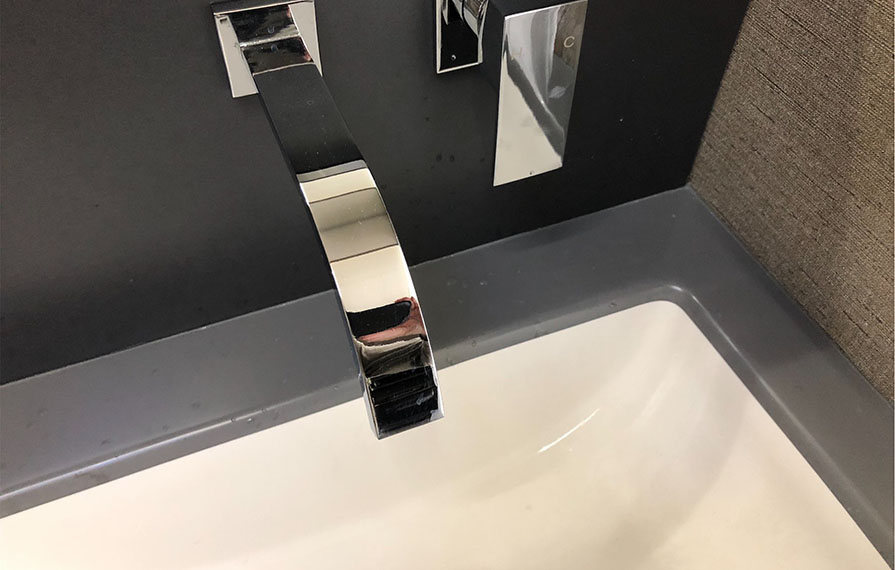
Classy = simple. This is the vanity faucet. Note the two-tone Corian sink with a silky smooth seam between the counter and sink which makes cleaning a breeze with a simple wipe down.
Winnebago has clearly broken free of the gravitational pull of traditional design and we know it won’t be for everyone. But at least now, in the diesel pusher segment, there’s finally a more modern feeling choice. Yet there’s another side of the design coin and, with sixty years of experience, it’s deep in Winnebago’s wheelhouse: floorplan design. Looking pretty and being functional are two different things. And I’m here to tell you that the Horizon absolutely lives as well as it looks. This 40A floorplan has a single bath, but the two entries (hall and bedroom) offer great pass-through access. The fixed kitchen island offers a lot more space than competitive galleys, and the uncluttered open space of the main living area is very, very flexible.
Both of the Horizon floorplan options are derived from well-honed Winnebago designs. They work. They make sense. And they make extended or full-time living exceedingly comfortable.
The driving and cab experience
The odds are you’re going to spend a lot more time living in a Horizon rather than driving one. But getting comfortably and safely from point A to B and all the points beyond is important. Moving you down the highway is a Cummins diesel in the rear. There are three key differences between the 40A and 42Q models. The 40A comes with a 400-horsepower engine and the 42Q bumps that up to 450 along with an independent front suspension and tag axle.
Coming from our Navion, we were immediately struck by the smoother ride and much quieter cab noise at freeway speeds. Terry appreciated the electric cover that slides over the front stairwell and comfortable passenger seat. I appreciated not only seat adjustability, but also the steering wheel tilt and adjustable brake and accelerator pedals.
The six-speed Allison transmission is fully electronic and controlled by push button. There’s a nifty switch that immediately puts the transmission in downshift mode when descending steeper grades which got a good test on the rolling up and downs of I-5 in southern Oregon. You can also make manual gear selections as it suits your driving needs.
Switches are all within reach, but pretty typical of the over-the-road truck heritage switch placement and labeling that’s pretty utilitarian. This isn’t a Winnebago shortcoming per se, I see pretty much the same arrangement in other competing products. What this means for new drivers is spending some time exploring and playing with the switches prior to taking your eyes off the highway while you search for the sun shade button (which looks like every other button). Though the Horizon’s molded dash curve looks as modern as the rest of the coach, it’s pretty clear that ergonomic user design hasn’t made it into the cockpit.
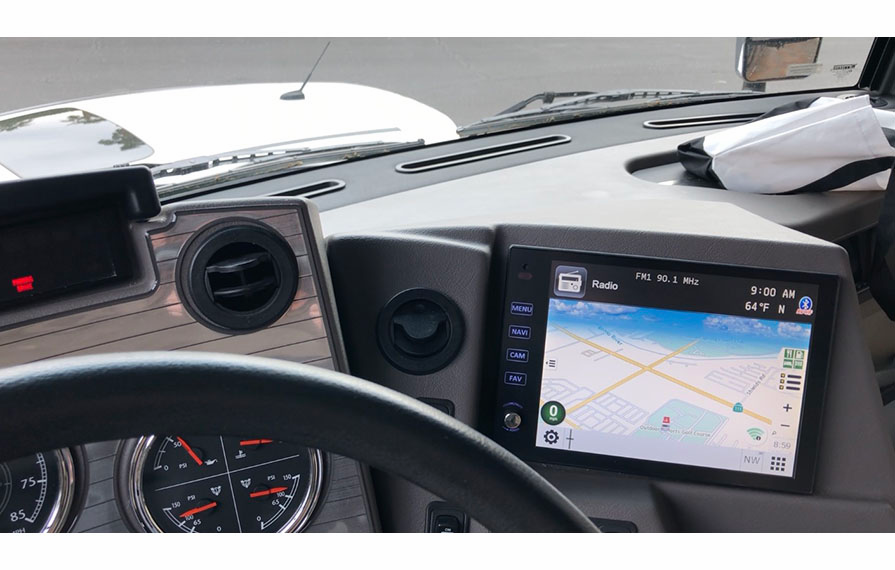
The large screen of the Xite infotainment system makes it easy to glance at information and get your eyes quickly back on the road.
So, while I’ll give the switches a C, the 10.5-inch Xite Infotainment system gets an A. That huge screen really makes a quick glance of the Rand McNally navigation display easy. And while the Winnebago signature high-quality side mirrors are excellent, the high-def cameras built into them display side traffic full screen when you activate the turn signal. I found this HUGELY helpful in looking at my blind spot on the right side of the coach. There were two instances where the video display revealed a vehicle on the right that wasn’t readily apparent in the mirrors.
Beyond the premium sound system, the Xite can also be used with a Sirius XM subscription and play music, audio books and podcasts through Bluetooth. You find Xite units in various Winnebago rigs and many people have a love-hate relationship with it. Those who love it (and I’m in that camp) are the ones who’ve patiently taken time to learn the deep features of the Rand McNally GPS software. No, it’s not as brilliantly friendly as Apple CarPlay, but it’s much better optimized for specific RV driving needs. (You can find a good video tutorial I produced by clicking here). There’s also a smaller passenger display that can also control many functions. And in front of the passenger seat is a hinged cover that opens up to reveal storage for various dash accessories along with dual USB and a 12-volt charge point. When parked, we have come to enjoy the standby feature that displays both the time and temperature outside the rig.
Finally, going down the road with the slides in, Terry had no problem accessing both the galley and the bathroom.
Smart furniture
Winnebago both makes and contracts furniture built to their exact specifications. In the front living area, both the driver and passenger chairs can be swiveled to face in and the passenger chair also has a pop-up footrest.
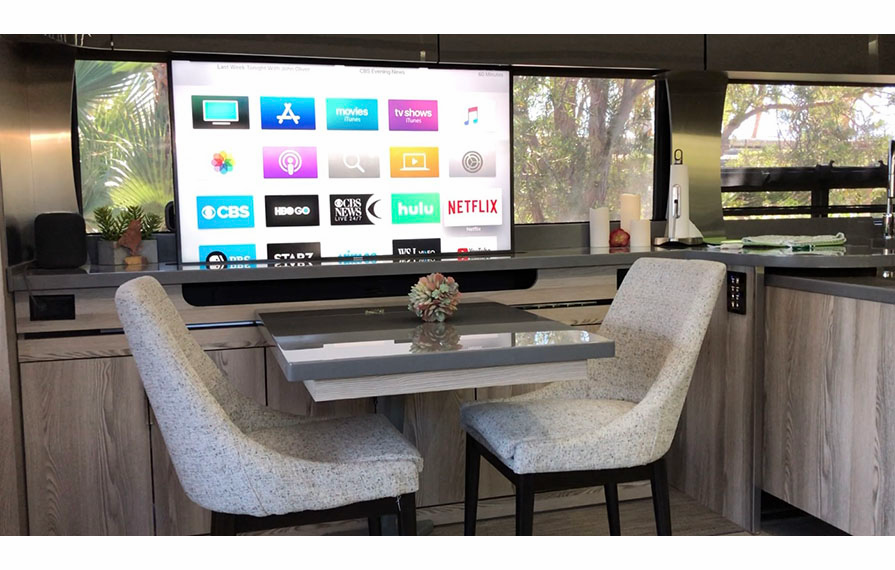
IMAX dining! We were surprised at the versatility of being able to move the dinette to the left and right. It's a feature we never thought we'd use, but did.
The “Glide and Dine” dinette is a Winnebago exclusive that always brings shocks and smiles as it’s being demonstrated. Pulling an under-the-table lever allows you to slide the table a couple of feet to the left and the right. It comes with two extension leafs that are slipped into vinyl-covered padded bags. With the two extensions in place, there’s comfortable space for four. There are two comfortable fabric covered side chairs with a hint of mid-century modern design. When company shows up, there are two wood-frame, solid and sturdy folding chairs that are equally well designed and comfortable. We’ve been living daily with one leaf in the table that adds a little extra surface for working with papers spread out next to our laptops.
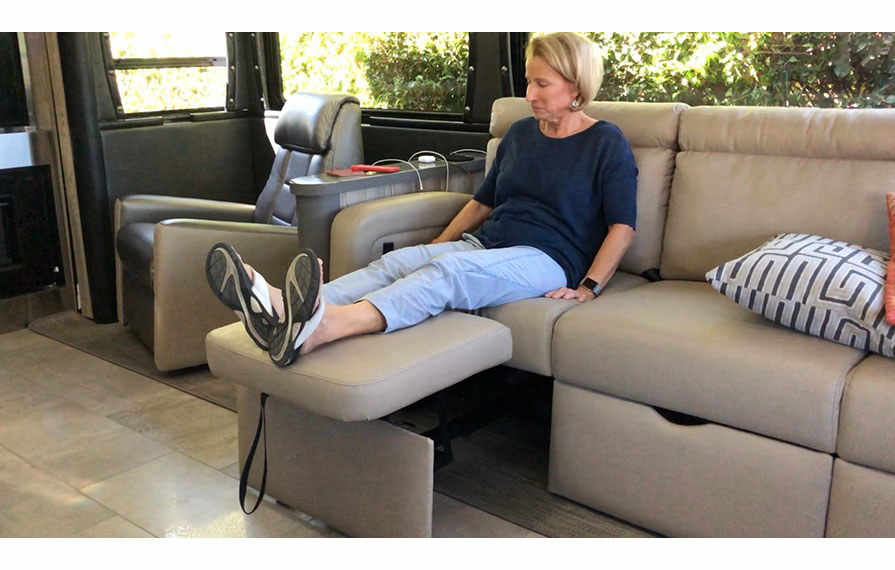
Most RV sofas have footrests that don't come all the way up to even out with the cushions which makes them less comfortable. This is a much better solution -- and sturdy, too. You can sit on the foot cushions without worry.
Across from the dinette is the “Rest Easy” sofa. I’ve shot a few videos demoing this piece of furniture, but now that we’re living with it on a daily basis, I’m here to tell you this ain’t no simple couch. All three seating cushions are motorized, so you can tilt them back for TV watching or flatten them out for sleeping. But here’s where it gets very, very cool. There’s a slot underneath the front cushion that you reach into to squeeze a release handle. You then pull out a sturdy steel rail frame with a matching top cushion that pulls up and locks firmly in place to form a footrest, ottoman, or sleeping extension. The footrest/ottoman is rock solid and you can sit on it without worry. The true brilliance to this design is that the ubiquitous ottomans you have to maneuver around in many coaches is completely unnecessary. During the day, the cushion and rail slides back under the sofa where it’s out of sight and no longer a tripping hazard.
As you’re sitting on the couch, there’s a thin end table that hides a fold-out table for use by the adjacent recliner. The recliner is a solid and reasonably heavy piece of furniture. Like all the seating areas, it’s covered in a premium grade of Ultraleather that is easy to clean, very durable and has a silky and sumptuous hand feel. The lounger can be swiveled to watch TV across the cabin or turn towards the fireplace for a chilly evening warm-up.
The other critical piece of furniture is the bed. A queen bed is standard and one big upside is the thin nightstands that parallel its narrower size (they aren’t available with the optional king size). It also makes maneuvering in the bedroom a bit easier. Our Horizon has a full-sized king, and like the queen version, it has an inflatable internal bladder system that allows you to adjust firmness with a wired memory remote. We started our marriage over three decades ago on a water bed and, before they were fashionable, have been sleeping on a Tempur-Pedic. We’re pretty fussy, but even for us, the Ideal Rest mattress in the Horizon is a pleasure to fall asleep on at night and wake up on every morning. And thankfully, the king-size bed is easy to make. The mattress is light enough that lifting the corners to pull on a fitted sheet isn’t hard.
Less a galley and more a kitchen
They say that the heart of a home is the kitchen and the central placement of the galley in the 40A truly makes that so. The number one benefit of this floorplan galley design is the fixed island.
RV kitchens are usually pretty stingy with counter space, and the Horizon really excels on this point not only with the island but with what I’ll call a coffee bar in a very practical cabinet stack. At the top is a large high-wattage residential convection/microwave. Below is an open and deep counter for a coffee maker, toaster oven, etc. We did find that our taller Keurig stores fine under the micro. But to use it, we slide it out toward the front of the counter, so the top lid can be opened. Below the counter is an optional Fisher and Paykel drawer-style dishwasher. If you don’t get this option, you get a second big roll-out pantry drawer. And there is also a big pantry drawer below which is ideal for taller items. This entire stack is hidden by cabinet doors that open and then slide back to remain out of the way for day-to-day access.
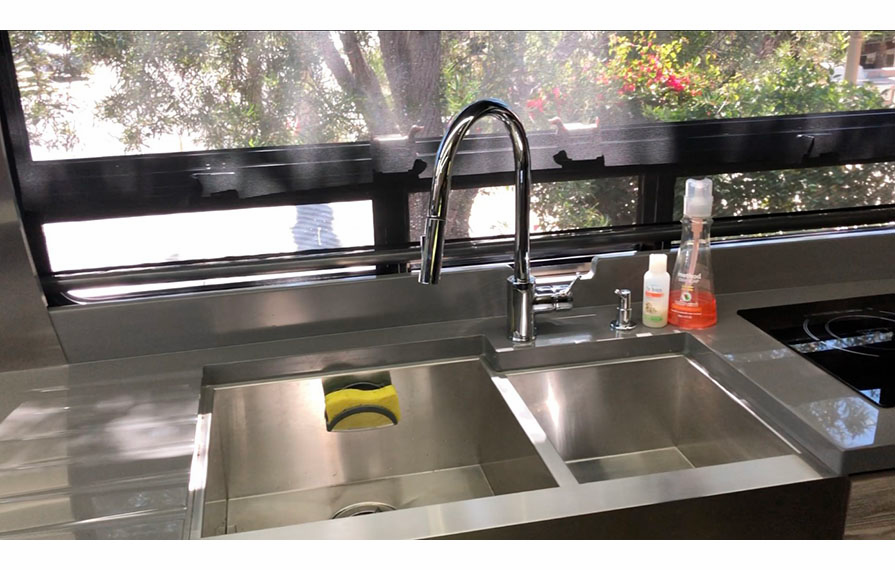
Splitting the difference with a large and smaller divided sink.
The kitchen sink is divided stainless. Winnebago has walked a fine line here with respecting that there are two camps when it comes to sinks. There’s the “one big sink” divinity and then the church of “the divided sink” brethren. The sink they’ve chosen is probably the theologically correct answer with a larger main sink and a smaller second one. We don’t mind it at all and we really like the stainless waterfall front facing. The large single-control faucet with integral hose sprayer is very equivalent to what we have in our loft at home.
Next to the sink is a two-burner induction cooktop. We discovered the joys of induction cooking several years ago with a portable unit for our Navion. Temperature controllability is really close to natural gas. You can read more about our induction experience here.
Filling out the galley compliment is the refrigerator. In our coach, Winnebago chose a French door, lower freezer model made by Samsung. We’ve had Sub-Zeros, Jenn-Aires, and Kitchen Aides and I think this Samsung compares quite nicely. It’s a 23-cubic-foot fridge which is LARGE. In residential appliances, you usually top out at 25 cubic feet, so this one is quite generous. There’s a lot of flexibility in shelf placement and I like that the ice maker and dispenser are built into the left top door. By putting the ice maker on the door, it frees up space in the freezer below. Finding items in bottom freezers can be a chilly treasure hunt. What’s nice about the Samsung is a sliding wire shelf that allows you to better organize and see what’s in the freezer.
In day-to-day use, the kitchen has been really easy for two people to work in at the same time without complicated choreography.
The bath with a wow factor
While the 42Q floorplan has a half bath and master bath, the 40A has a single one and it’s a masterpiece. Now that’s not just me cranking up the rave machine, we hear this from absolutely everyone who has toured the coach. So, let’s start our tour with the modern barn door in the hall suspended on a roller and stainless-steel rod track. Then there’s the entrance into the bedroom that can be divided by a pocket door. With the doors open, we find ourselves using both the hall and bath entrances as we move back and forth from the bedroom to the coach. There’s never a traffic jam and the dual flow somehow seems to make a lot of sense.
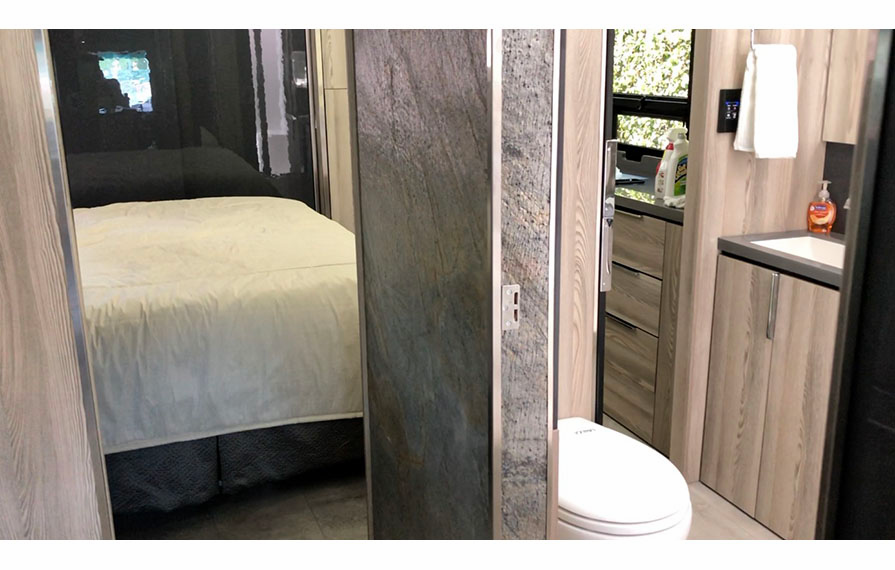
Two entries into the bathroom makes it feel even larger than it is.
It’s a toss-up as to which is more dramatic, the floor to ceiling backlighted stainless-steel panel in the shower, or the wall-mounted, single-control faucets for the dual vanity. With a natural skylight, backlit wall panel, and tube-ring LED lighting, taking a shower seems to be a more enervating experience. There’s a molded seat built at the right height for in-shower leg shaving or setting down a shampoo bottle. The single-handle control feeds a flexible shower head that can be positioned vertically on a slide rail at various heights and is easily detached for washing off bare feet or being a doggie spa.
The dual vanities are seamless Corian with integral sinks that make wiping them down easy and fast. The sink stoppers are a wide stainless pop-down-to-plug design. A very sensible choice.
And finally, in the porcelain department, there’s a Thetford Tecma toilet. It’s a very stout and comfortable design that keeps a little base water in the bottom of the bowl. It’s an electric flush with two-lighted buttons on the wall next to it for light and heavy flushing. No foot pedal or cleaning hose. The more powerful flush cycle does a pretty good job flushing out solids, but definitely invest in a small bowl brush. We found that it fits very nicely in the dead corner to the rear of the toilet. The Tecma uses more water for flushing than traditional RV stomp and dump mechanisms, but with this class of coach you’re more than likely to be hooked up and not worrying about water sufficiency. There’s also a nifty indicator light on the flush buttons to tell you when the black tank is getting full.
Beyond the high-quality fixtures, the other “wow” moment about the bathroom in the 40A is how much storage there is. There are two open cabinets below the sink, a stack of three center drawers, three medicine cabinets, a tall and shallow two-door storage cabinet next to the toilet, and a large and deep (though a bit narrow) closet behind the toilet that might best be used for linens and cleaning supplies.
Storage (above)
Just like the bathroom, Winnebago really optimizes storage and, unlike many competitors, they do it in a really smart way. Like so many features in motorhomes, things are often designed to captivate and capture a buyer’s heart as they walk through a coach at a dealer or RV show. Some of those ideas at first glance seem super clever, but after you start living with a coach that first impression of admiration can quickly turn to “what were they thinking?!?!” Throughout all their motorhome products, Winnebago does a pretty good job of prioritizing usable over sexy when it comes to storage, and the Horizon reflects that kind of thoughtfulness.
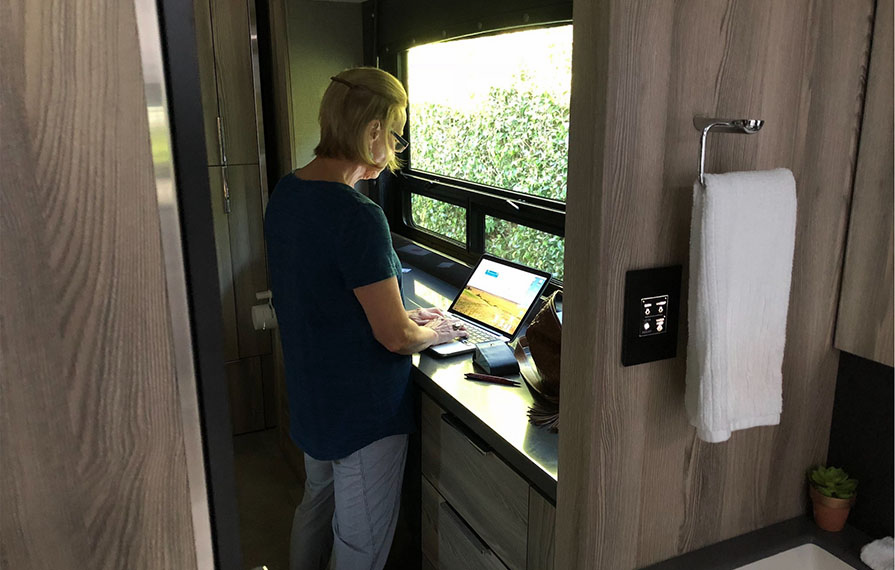
Terry liked that the dresser was also a perfect stand-up desk, with plenty of storage below.
I’ve produced quite a few videos of Winnebago’s Class A products over the past few years and my sense is that there is a subtle trade-off between panoramic visibility and storage in the Horizon. For instance, in the 40A we have a lower dresser (with a televator) and above is a large window. In the 42Q there’s no window, it’s all storage.
When I tell you that we downsized from a four-bedroom, 3,800 square foot house to a two bedroom 1,500 square foot loft, and have traveled in Navions for the past five years, that’ll pretty much tell you where I’m coming from. Less stuff means less hassle. But I think the Horizon 40A is perfectly capable of storing everything that a multi-month Snowbird or full-timer would want or need without much in the way of trade-offs. In our primary residence, we’ve learned to edit wardrobes and home accessories to the best and most essential items and have never felt we cut corners or that we were missing something.
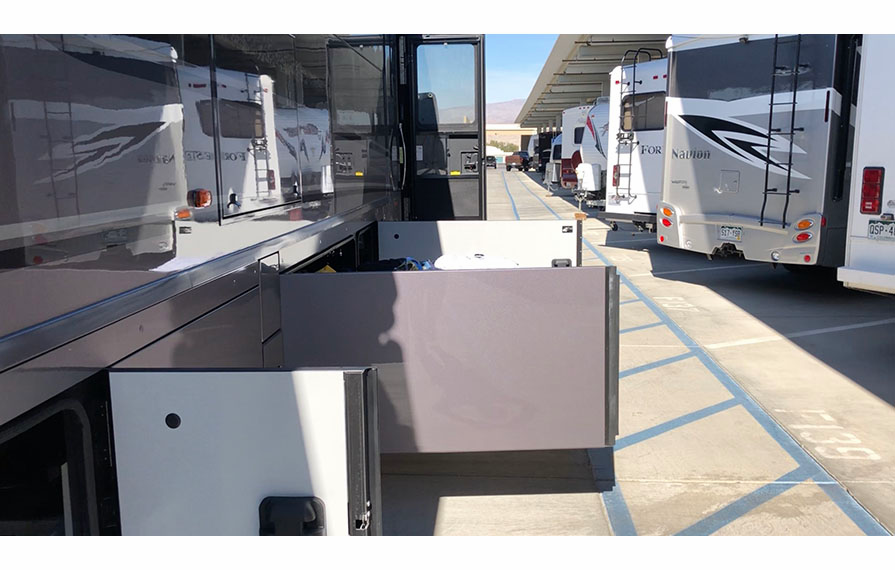
It took us longer than expected to transfer clothing, food, tools, etc from our Navion to the Horizon.
For our extended desert stay, we essentially emptied out our Navion into the Horizon and we have tons of space we’re not using.
In the main living area, there are four wide and deep overhead cabinets on each side (eight total). There are two more tall and wide cabinets over the dash with a little side storage above the door. Over the fireplace are another two shallow, but wide cabinets.
Under the dinette bar, six cabinet doors open into two deep and divided cabinets on both sides of the shallow televator cabinets.
Galley storage is pretty good with large, open capacity under the sink, three deep pullout drawers and two overhead cabinets. Terry and I both think that we’d dedicate the cabinets over the fireplace to additional galley use either for foodstuffs or glassware. Figuring out kitchen storage is more an art than it is a science and you may come up with a completely different strategy than ours. Suffice it to say, at least you have options.
In the bedroom, the main wardrobe closet is a little over five feet wide and accessed by very solid bypass doors. There’s an additional 7-1/2 inches of depth behind the hanging clothes with some fixed shelves. This would be great for seasonal storage, shoes, and infrequently used items. The wardrobe closet is the only place you’ll see a typical RV puck light and the LEDs are bright and really help you see your clothes. Underneath the washer and dryer cabinet is a nifty long and deep storage drawer which can act as a small dirty clothes hamper or detergent storage. On the other side of the bedroom, hidden behind the articulated doors leading to the hall, there is a tall, long, and skinny floor to ceiling closet that offers storage options for smaller items like socks, paperbacks, pet supplies, etc.
We are big fans of The Container Store’s plastic shoe boxes and have used many of them in the Navion. We’ve moved some of them into the Horizon and they’re excellent for storage organization in the overhead cabinets and the bedroom closet. And here’s a super cool thing I discovered: For sound dampening and item protection, Winnebago lines many of their cabinets with a very low-pile, carpet-like material. It’s the kind of stuff that Velcro sticks to beautifully. This opens up many possibilities for creating divided and secure storage in many of the cabinets.
Storage (below)
Diesel pushers in general have lots of “basement” storage. On the Horizon, there are 5+ storage compartments. The “plus” comes from a couple of bays that have mechanical equipment, but also good storage cubbies. At the heart of the Horizon basement storage is a double-wide bay with a roll-out tray that can be accessed from either side of the coach. I haven’t seen this kind of wide storage in other, far more expensive, coaches and it’s due to Winnebago’s custom Maxum chassis which lowers the coach rails, improves center of gravity, and allows for this super-wide storage drawer that has even more fixed storage below and on the side. It’s pretty impressive.
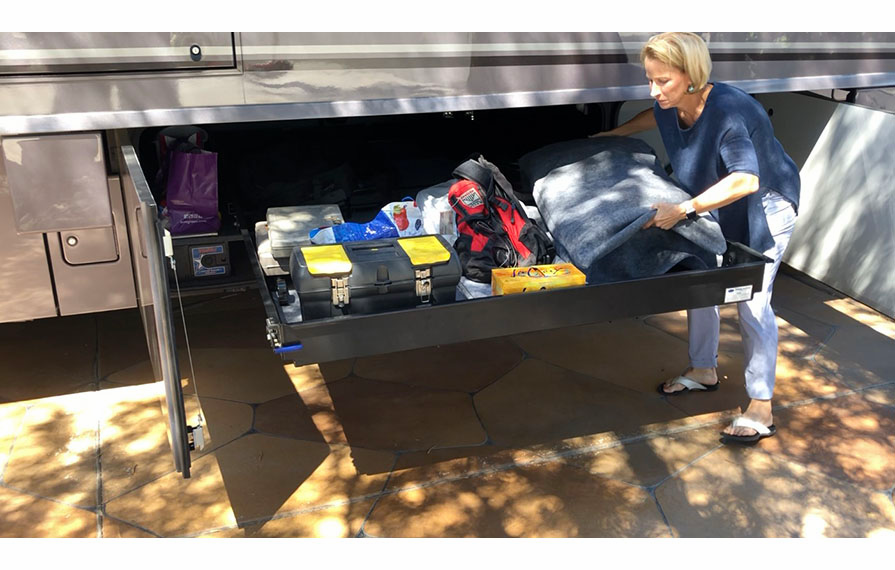
That's one BIG storage bay!
One of the other storage bays on the passenger side can be fitted with a roll-out Dometic freezer/refrigerator which is ideal for ultimate tailgating or Costco miscalculations where you just couldn’t pass up the 10 pounds of USDA Prime. And while we’re on the subject of bays and tailgating, there’s a bay up front on the driver’s side where a 20-pound LP tank is stored. When connected, the tank feeds a connection tap on the passenger side of the vehicle to power a propane barbecue that you supply. What a treat not having to mess with a bunch of one-pound bottles and worrying about running out of gas before dinner is cooked.
All the large bays have bright internal lights and you can turn them on and off from a variety of locations including an inside panel right at the front entry.
Surfaces
Unlike larger residential spaces, the smaller space of an RV tends to take you much closer to finishes. While it didn’t hit us immediately, after a couple of weeks in the Horizon we started noticing things we hadn’t paid attention to before. The first was the absence of the traditional RV papered wallboard. You won’t see any of it in the Horizon. The wall surfaces behind the sofa and recliner are padded soft vinyl panels. The same holds true for the main ceiling panels. The walls around the bath and leading to the bedroom are highly dimensional laminate that have the appearance of variegated slate. It’s an unusual product and an even more unusual application of it. The lighter porcelain tile in this model has a very good foot feel. Though smooth, there is a slight roughness to the surface that makes it less slippery in socks or when stepping out of the shower.
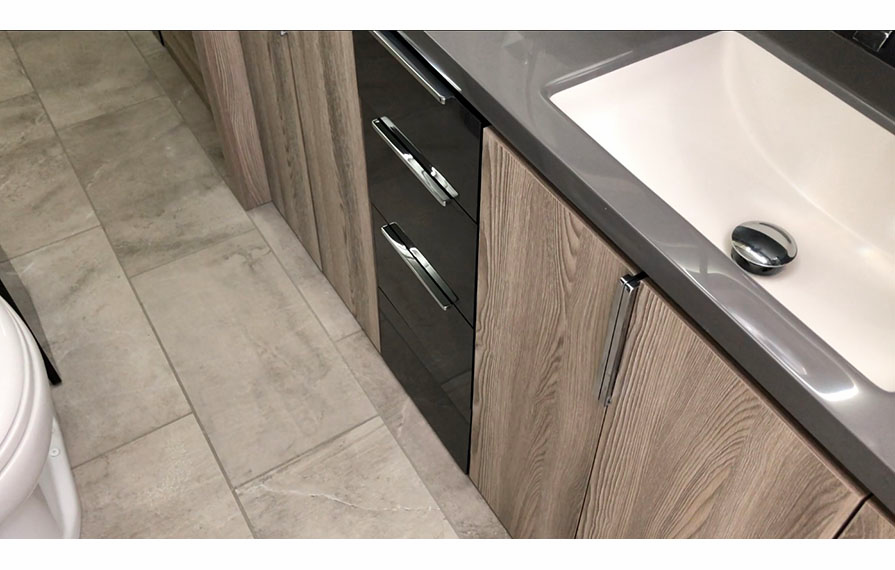
From great foot feel on the tile, to the soft padding around window frames, every surface of the Horizon is a pleasure to touch.
The Italian-made Technoform cabinetry is a high-gloss laminate. And yes, fingerprints do show up, but we’ve found that it’s a minor issue and a quick wipe takes care of it. The glass-like finish of the cabinet doors and matching door panels adds to the sense of spaciousness with their high degree of reflectivity. All the positive locking overhead cabinet latches are hidden right underneath the doors and the larger cabinet doors and drawers have these thin chrome pulls that are barely noticed. However, they provide an excellent grip — especially for the positive soft-close drawers. These are the subtle touches you just don’t see in motorhomes in this price range (or often higher) and they’re next to impossible to notice as you dart in and out of various makes and models, but these are the small details that, in aggregate, lead to a more comfortable and satisfying living experience.
Windows, shades and awnings
I’ve talked earlier about how much we enjoy all the expansive glass on the Horizon. This afternoon as I was reviewing the draft of this story, I saw a Newmar London Aire back into a space near ours. I was struck by the large size of the windshield. My friend who owns a similar Essex told me the replacement cost of the window (which he had to do). That’s one expensive piece of glass and a good argument for insurance. While it gives the coach a bold look on the outside, on the inside a lot of that real estate is hidden behind the front cabinets.
I looked at the London Aire and then again at the Horizon. Both are handsome coaches, but the Horizon gives you all the windshield you actually need which, heaven forbid, is a lot less glass to replace without any sacrifice in wide angle views from the front seats.
All the Horizon shades are manual except for the front sun and blackout shades which are controlled from a switch to the left of the driver’s seat. There’s a limiter that lowers the shade enough for driving into the sun, but not too far when you’re driving. When parked, you can set them at any height. All the rest of the shades are the field-proven MCD mechanisms with both sun and blackout shades which I have always found to work well.
There are two exterior awnings. One over the front door and the other down the passenger side. Both have wind sensors for auto retraction and embedded LED lights.
Electronics
I’ve already discussed the Xite infotainment system with optional premium sound speakers. It’s worth noting that the sound system is strictly for the front cab. For the home entertainment electronics, there’s a cabinet and rack above the driver’s seat where there are shelves, outlets and connections for satellite, cable, and internet. Additionally, there’s a pre-installed Blu-ray DVD player. Our coach has four TVs. One on the outside with a soundbar and wireless sub-woofer, two screens (dining and bedroom) on televators that are controlled from light panels, and an optional fourth 50” screen above the fireplace.
We found that we never turned on the big screen above the fireplace and would just as soon pass on that option and go with the more stylish cabinets instead. There are two reasons for that. The first is that we (like most people) like watching TV directly facing the screen. The only seats that really do that are the rotated driver and passenger seats. On the other hand, the sofa – with its built in electric recliner and pullout ottoman – directly faces the dinette screen. And while it’s just a tad smaller, this is a more sophisticated Samsung than the other sets and it has an excellent soundbar and subwoofer. We also have found that it’s impressively cinema-like to sit at the dinette table with the chairs angled to watch TV.
I think Winnebago has made a wise decision to forego adding a stereo system and speakers in the coach. I find many friends who simply don’t turn them on for watching TV. Too many remotes. Too complicated. The main cabin TV soundbar sounds excellent. If you do love listening to music (and I do) then consider a standalone solution like Apple’s wonderful HomePod. It arrived at the coach on the first day of shipping and it’s a winner being able to stream Apple Music from the internet or from our iPhones and iPads. I also recommend the competitive products from Sonos. Either way, you’ll get great sounding music without any wiring or control hassles.
For video signals, the Horizon comes with an autoseeking Winegard HD antenna which has worked well for over the air signals. You can also order a Winegard satellite dish. For the past couple of months, we’ve found that a combination of over-the-air and streaming have been a perfect solution. For $44 dollars a month, we have a 100Mb internet cable modem connected to an AppleTV. More and more streaming is where it’s at and with a modem connection we use the AppleTV as our main viewing hub to access our Netflix, Amazon, Hulu, and HBO subscriptions. The pro-class HDMI switcher in the electronics cabinet allows you to send signals from any source to any TV to support different programs in different locations.
For in-coach WiFi, I installed some nifty WiFi routers from Google. There’s one in the front electronics cabinet plugged into the cable modem. Then I put one in the back in the bedroom and through a simple app they connected and formed a “mesh” network. This gives us strong WiFi on the side and back patio on our lot which is great for using my portable outside Bluetooth speaker or fast surfing on my Mac or iPad outdoors.
Systems
Engine
This class of motorhomes all put a lot more emphasis on the word home rather than motor. However, it’s worth pointing out a few things about the vehicular aspect of the Horizon. One of the big conveniences is having locking diesel fill doors on both sides of the coach for maximum flexibility in filling up. A large DEF tank with an easy-to-read gauge is on the driver’s side to the rear. It’s far enough from the diesel fill that you may have to roll the coach forward about 10 feet if you’re at a pump that also has a DEF dispensing nozzle.
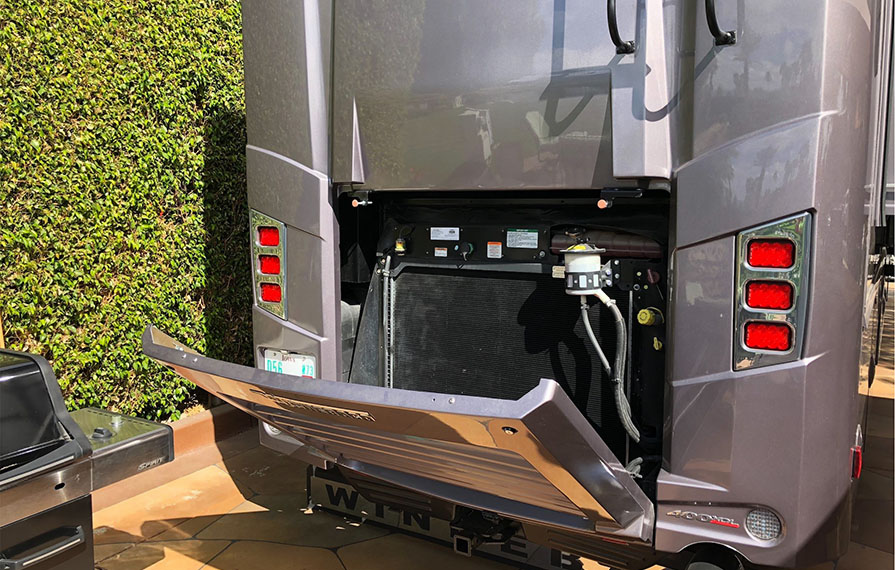
The 40A has a 400HP engine and the 42Q has a 450HP engine.
Service is pretty straightforward. The 40A is a rear radiator and the 42Q has a side radiator. Some owners, who are mechanically inclined, will say they prefer the side radiator style for easier service. For owners like me, I’m happy to tend to other systems and let the engine guys handle the oil changes and routine service.
At the back of the coach is a 2” hitch receiver with standard 7-way connection that supplies power to an auxiliary braking system in a tow car. Oh yes, you can tow a really, really big car as the hitch rating is for 15,000 pounds.
Generator
The Cummins Onan generator is in the front of the coach and can be manually pulled forward for access to service. It’s a 10,000-watt generator that’s capable of running the three ceiling air conditioners. In running it, we were certainly aware it was on, but the noise and vibration wasn’t bothersome. In the back of the coach, you are barely aware of it, so if you found yourself spending a hot night in a Walmart parking lot or boondocking in Quartzite, the generator could run all night and keep the air conditioning going without keeping you up. There is also an automatic generator start (AGS) which monitors house battery level and automatically starts up the generator before battery levels get too low.
Electrical
The Horizon is an all-electric coach and, especially with a residential refrigerator, there are six AGM batteries to supply power when not connected to shore power or running the generator. For those times you’re strictly on batteries, there’s a 2,800-watt inverter to keep juice running to the refrigerator and lower wattage 110-volt electrical devices. On the roof is a 100-watt solar panel which can be easily expanded. Now this isn’t enough solar to meaningfully power devices, but it’s excellent for topping off battery charge and maintaining long battery life - especially if you’re storing your rig outside for extended periods.
For shore power, there’s a thick 50-amp cable that stores in a bay large enough so you don’t have to wrestle with cramming a cable that’s become stiff at low temperatures. We’ve felt there are a decent amount of 110-volt outlets throughout the coach and really, really appreciate that many of them also have two USB ports in the receptacle.
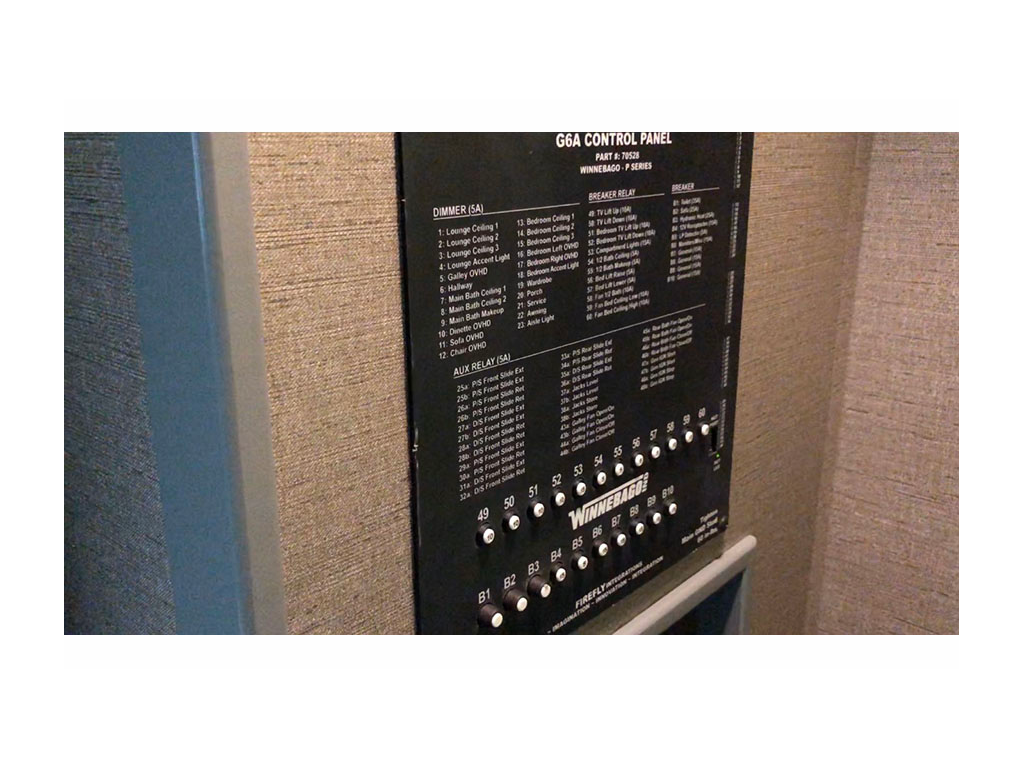
The Firefly multiplex control panel is in the closet and is surprisingly easy to read and figure out if a relay needs to be reset.
The 12-volt system operates lights, ventilation fans, and the televators. There are two suppliers to the RV industry, Silverleaf and Firefly. Generically, this is referred to as multiplexing. Both systems are very powerful and capable, but I personally like the Firefly system that Winnebago uses because of the clarity of interface in their panels. After all, you don’t want to spend time puzzling switches out on a daily basis. All the panels are backlit which makes them easy to see in the dark. If that’s too bright for you, there’s a button you can push that turns the lights off.
Every panel has a different mix of controls depending where it’s placed in the coach. There’s a couple of panels you might not see at first. One is above the sofa, which has lighting control and raises/lowers the TV. The one over the bed offers lighting and televator control, but also allows you to start the generator from bed. Nifty. The Firefly design uses a small blue indicator, so you can see at a glance if a light or device is active. Most of the light control buttons also have a dimmer. Simply press and hold and the lights will cycle from dark to light where you can choose the optimum level.
The main Firefly control panel not only gives you control over all the coach lighting, but also is where you monitor tank levels, electrical system health, slideouts, and heating and cooling. The interface was very easy to figure out and I didn’t need a manual to explain the control options.
Heat and air conditioning
There are two systems. One below and one above. Below the floor of the coach is an Aquahot heating system. The Aquahot is both a water and radiant heating system. It can run off of either electricity or diesel. If you want to heat the coach (or water) quickly, you simply turn on the diesel burner from the master Firefly panel. I’ve found that you can start with a quick diesel heat-up and then maintain temp throughout the day with electric. The diesel heater makes a low-pitched hum which isn’t distracting, and it can barely be heard a few feet away from the coach. For heating the coach, you have three zones. The main cabin, bedroom, and underneath storage bays (for keeping plumbing from freezing on very cold nights). The Aquahot circulates an anti-freeze glycol fluid through coils across which zone fans blow and put the hot air through vents that are well placed.
An electronic fireplace uses an electric element and fan to actually put out heat. A few years ago, when we saw an electric RV fireplace we thought they were pretty hokey. Well, our opinion has taken a 180 as this fireplace puts out enough heat to take the chill off a cold evening and, with all its fancy wireless control, actually looks aesthetically pleasing.
Up top, there are three air conditioners that can also act as heat pumps. However, heat pumps rapidly lose their effectiveness when the air temps drop below fifty degrees. On one cold northern California morning, we gave them a go to help bring the temp up quickly. Within about five minutes, they started blowing warm air. But we also supplemented with the Aquahot furnace which, in combination, got us to a pleasant cabin temperature in about ten minutes.
In hot (and humid) climates, the air conditioning can be running all the time. The Winnebago ceiling design offers both good air distribution and some degree of sound baffling. The net effect is that you’re aware the air is on, but can still carry on a conversation and, with a slight bump in volume, hear the TV. If the hot nights cool off a bit, there’s a silent and effective two-speed ceiling fan in the bedroom to keep air moving around which can be turned off either at the wall panel or the panel right above the bed.
Water
The outside water and sewer service bay is large and easy to access. There’s a Firefly panel that allows you to turn on compartment and exterior work lights along with the water pump. Hose and sewer connections are fairly high and don’t require a lot of bending over. I also appreciated the black tank flush and rinse connection.
Central vacuum
There is a port mid-way in the coach that, when you plug in the heavy duty hose, automatically starts a strong vacuum. The expandable hose stretches to get to every corner of the coach and comes with several tools. You can access it from the main storage hatch where there is another port. This came in quite handy to vacuum dust off of some of our patio furniture outside.
Washer and dryer
In this long, long parade of features, it’s important to give a shout out to the Splendide stacked washer and dryer units made by Ariston. These can handle modest RV-sized loads and we were both really impressed by the cleaning ability of the washer and the power of the dryer which has to be heated with a 110-volt line. You’ll feel a slight wobble in the coach when the washer goes into spin cycle, but beyond that, this petite combo has been doing a fine job.
Saving the best for last - a long warranty
Winnebago is putting their money where their mouth is by backing their quality with the industry’s best warranty. It’s a full three-year warranty on the coach itself which is unheard of. That certainly gives buyers some piece of mind and economic certainty for three years.
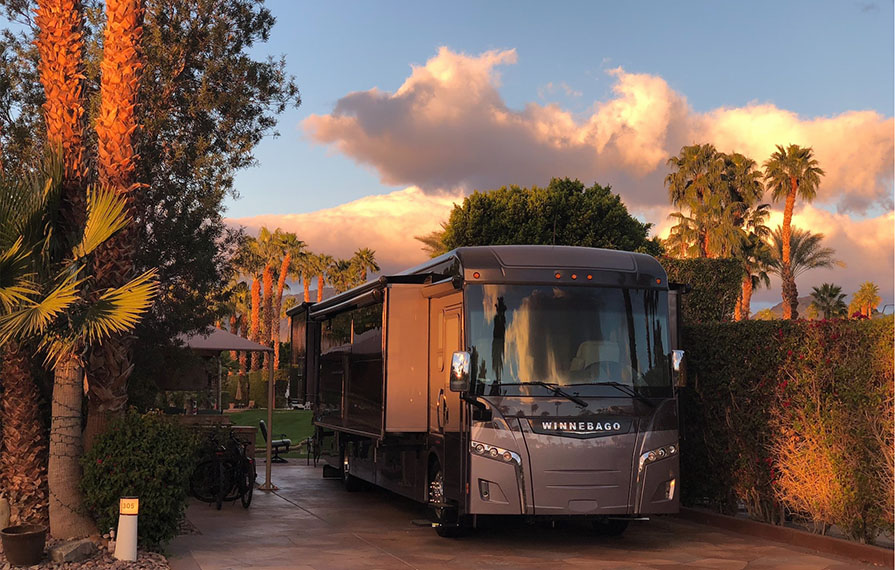
Final thoughts
By their nature and design, diesel pusher motorhomes are created for extended living over weeks, months or year-round. Every floorplan and feature set is a study in compromise, and all run hard up against the legal limitation of highway size.
In the couple of months we’ve been living in the Horizon, we’re both surprised and pleased at its livability, comfort and convenience. We’ve rarely found ourselves saying, “gee why couldn’t we have that feature” or “boy, what was Winnebago thinking?” Our living test has been one of gradual discovery, not only of features, but how we adapt to them.
Within the resort we’ve been staying, there’s a strong representation of top-end coaches that include products from Prevost, Marathon, Foretravel, Newell, Newmar, Entegra, Tiffin and (of course) Winnebago. From the outside, our Horizon is subtly different, but you have to linger for a moment to appreciate its elegant simplicity. But walk five steps up into the coach and it only takes a moment for an eyebrow to raise or someone to exclaim “wow.” And it’s not an over-the-top wow, it’s a recognition of a design that is at once, completely new and immediately comfortable.
Of course, that leads to the next question of “how much is it?” That’s when the second shock wave hits that, in some cases, it’s a third to a quarter of the highest-end coaches. And when owners from similarly priced coaches in the $300-$500 thousand-dollar range walk through, both their reactions and their comments reflect a consistent sense of wishing that the Horizon was available when they bought their current coach.
The Horizon brings a remarkable balance of RV features with a palpable feeling of style that makes every morning and every evening a relaxing and comfortable environment you want to be in. It’s the first Class A that has ever opened us up to considering moving from our well-loved Navion. I never would have thought that was possible, but that’s what the power of good design does - it invites and inspires.
Click here for full specs, floorpans, colors, and virtual tours of the new Horizon.
Comments
Comments on this post are moderated, so they will not appear instantly. All relevant questions and helpful notes are welcome! If you have a service inquiry or question related to your RV, please reach out to the customer care team directly using the phone numbers or contact form on this page .